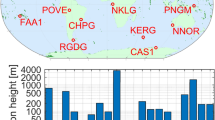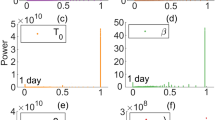Abstract
Today Global Navigation Satellite Systems (GNSS) tropospheric products, such as zenith total delays (ZTD) and zenith wet delays (ZWD), are widely used as complementary data sets in numerical weather prediction models. In particular, the wet delays are treated as unknown parameters in GNSS processing and are estimated with other parameters such as station coordinates. In this study, we investigate the effects of Phase Center Correction (PCC) models on ZWD, integrated water vapor (IWV) and horizontal gradients derived from Global Positioning System (GPS) observations. Two solutions were generated using the GAMIT software over the European Reference Frame (EUREF) Permanent GNSS Network (EPN). The first (reference) solution was derived by applying the International GNSS Service (IGS) type-mean PCC models, while for the second solution PCC models from individual calibrations were used. The solutions were generated identically, except for the PCC model differences. The tropospheric products from the two solutions were then compared, with the assumption that common signals would be differenced out. The comparison of the two solutions clearly shows a bias in all tropospheric products, which can be attributed to PCC model deficiencies. Overall, mean biases of 1.8, 0.3, 0.14 and 0.19 mm are evident in ZWD, IWV, North–South and East–West gradients, respectively. Moreover, the differences between the two solutions show seasonal variations. For all antenna types, the ZWD and IWV differences are dominated by white plus power-law noise, with the latter characterizing the low-frequency spectrum. On the other hand, the horizontal gradients exhibit a white plus first-order autoregressive noise characteristic with less than 1% white noise. The individual PCC model provides a better fit to an external independent model in terms of gradient estimates and also provides up to 3% more carrier phase integer ambiguity resolution.








Similar content being viewed by others
References
Araszkiewicz A, Volksen C (2017) The impact of the antenna phase center models on the coordinates in the EUREF permanent network. GPS Solut 21(2):747–757. https://doi.org/10.1007/s10291-016-0564-7
Baire Q, Bruyninx C, Legrand J, Pottiaux E, Aerts W, Defraigne P, Chevalier JM (2014) Influence of different GPS receiver antenna calibration models on geodetic positioning. GPS Solut 18(4):529–539. https://doi.org/10.1007/s10291-013-0349-1
Balanis CA (2005) Antenna theory: analysis and design, 3rd edn. Wiley, Hoboken
Bar-Sever YE, Kroge PM, Borjesson AJ (1998) Estimating horizontal gradients of tropospheric path delay with a single GPS receiver. J Geophys Res 103(B3):5019–5035. https://doi.org/10.1029/2004JD004536
Bevis M, Businger S, Herring T, Rocken C, Anthes RA, Ware RH (1992) GPS meteorology: remote sensing of atmospheric water vapor using the global positioning system. J Geophys Res 97(D14):15787–15801
Boehm J, Werl B, Schuh H (2006) Troposphere mapping functions for GPS and very long baseline interferometry from European center for medium-range weather forecasts operational analysis data. J Geophys Res 111(B2):B02406. https://doi.org/10.1029/2005JB003629
Boniface K, Champollion C, Chery JV, Ducrocq Rocken C, Doerflinger E, Collard P (2012) Potential of shipborne GPS atmospheric delay data for prediction of Mediterranean intense weather events. Atmos Sci Lett 13:250–256. https://doi.org/10.1002/asl.391
Bos MS, Fernandes RMS, Williams SDP, Bastos L (2013) Fast Error Analysis of Continuous GNSS Observations with Missing Data. J Geod 87(4):351–360. https://doi.org/10.1007/s00190-0120-0605-0
Byun SH, Bar-Sever YE (2009) A new type of troposphere zenith path delay product of the International GNSS Service. J Geod 83(3–4):367–373. https://doi.org/10.1007/s00190-008-0288-8
Douša J, Dick G, Kacmarík M, Brožková R, Zus F, Brenot H, Stoycheva A, Möller G, Kaplon J (2016) Benchmark campaign and case study episode in central Europe for development and assessment of advanced GNSS tropospheric models and products. Atmos Meas Tech 9:2989–3008. https://doi.org/10.5194/amt-9-2989-2016
Fang P, Bevis M, Bock Y, Gutman S, Wolfe D (1998) GPS meteorology: reducing systematic errors in geodetic estimates for zenith delay. J Geophys Res Lett 25:3583–3586
Gradinarsky LP, Johansson J, Bouma HR, Scherneck HG, Elgered G (2002) Climate monitoring using GPS. Phys Chem Earth 27(4):335–340. https://doi.org/10.1016/S1474-7065(02)00009-8
Guerova G, Jones J, Douša J, Dick G, de Haan S, Pottiaux E, Bock O, Elgered G, Vedel H, Bender M (2016) Review of the state of the art and future prospects of the ground-based GNSS meteorology in Europe, Atmos. Meas Tech 9:5385–5406. https://doi.org/10.5194/amt-9-5385-2016
Herring TA, King RW, Floyd M, McClusky S (2015) Documentation for the GAMIT GPS analysis software 10.6. Massachusetts Institute of Technology Department of Earth Atmospheric and Planetary Sciences USA
Klos A, Hunegnaw A, Teferle F, Abraha KE, Ahmed F, Bogusz J (2018) Statistical significance of trends in Zenith Wet Delay from re–processed GPS solutions. GPS Solut 22:51. https://doi.org/10.1007/s10291-018-0717-y
Lomb NR (1976) Least-squares frequency analysis of unequally spaced data. Astrophys Space Sci 39(2):447–462. https://doi.org/10.1007/BF00648343
Lyard F, Lefevre F, Letellier T, Francis O (2006) Modelling the global ocean tides: insights from FES2004. Ocean Dynam 56:394–415. https://doi.org/10.1007/s10236-006-0086-x
Mahfouf J-F, Ahmed F, Moll P, Teferle FN (2015) Assimilation of zenith total delays in the AROME France convective scale model: a recent assessment. Tellus A Dyn Meteorol Oceanogr 67(1):26106
Meindl M, Schaer S, Hugentobler U, Beutler G (2004) Tropospheric gradient estimation at CODE: Results from global solutions. J Meteorol Soc Jpn Ser 82(II):331–338. https://doi.org/10.2151/jmsj.2004.331
Petit G, Luzum B (2010) IERS conventions (2010) IERS technical Note 36. Verlag_ Bundesamt für Kartographie und Geodäsie, Frankfurt. ISBN 3-89888-989-6
Press WH, Teukolsky SA, Vetterling WT, Flannery BP (1992) Numerical Recipes in Fortran 77, vol 1, 2nd edn. Cambridge University Press, New York, pp 569–573
Rothacher M (2002) Estimation of station heights with GPS: vertical reference systems. International Association of Geodesy Symposia, vol 124. Springer, Berlin
Rothacher M, Mervart L (1996) The Bernese GPS software version 4.0. Astron Inst. Univ. of Berne, Berne
Schmid R, Rothacher M, Thaller D, Steigenberger P (2005) Absolute phase center corrections of satellite and receiver antennas. GPS Solut 9(4):283–293. https://doi.org/10.1007/s10291-005-0134-x
Schön S, Kersten T (2014) Comparing antenna phase center corrections: challenges concepts and perspectives. in IGS AC Workshop 2014. https://www.ife.uni-hannover.de/uploads/tx_tkpublikationen/IGS2014_schoenKersten.pdf
Shoji Y (2013) Retrieval of water vapor inhomogeneity using the Japanese nationwide GPS array. J Meteorol Soc Jpn 91:43–62
Sidorov D, Teferle FN (2015) Impact of Antenna Phase Centre Calibrations on Position Time Series: Preliminary Results. In: Rizos C, Willis P (eds) IAG 150 Years. International Association of Geodesy Symposia, vol 143, pp 117–123 Springer, Cham. https://doi.org/10.1007/1345_2015_216
Steigenberger P, Tesmer V, Schmid R, Rothacher M, Rülke A, Fritsche M, Dietrich R (2009) Effects of different antenna phase center models on GPS-derived reference frame. In: Drewes H (ed) Geodetic reference frames. Springer, Berlin, pp 83–88. https://doi.org/10.1007/978-3-642-00860-3_13
Tregoning P, Reinout B, O’Brien D, Hendy M, (1998) Accuracy of precipitable water vapor estimation from GPS observations. J Geophys Res 103(9–10):28901–28910. https://doi.org/10.1007/s00190-002-0283-4
Williams SDP (2003) The effect of coloured noise on the uncertainties of rates estimated from geodetic time series. J Geod 76:483–494
Acknowledgements
Mr Ejigu is grateful to Wolkite University, Ethiopia, for providing computer facilities and working space. Dr Hunegnaw and Mr Abraha were funded by the University of Luxembourg SGSL project and the Fonds National de la Recherche (FNR) Luxembourg MGLTM project (Grant# 6835562), respectively. GPS data and products used in this study were retrieved form the EPN at http://www.epncb.oma.be/ and IGS archives. The GPS data were analyzed using the GAMIT software package version 10.6. We are grateful to Jan Dousa at the Geodetic Observatory Pecny, Czech Republic, for providing the ERA-Interim derived ZTD and gradient time series data. We also acknowledge tropospheric gradients parameters estimated at the Nevada Geodetic Laboratory for external validation. The Generic Mapping Tools (GMT) version 5 software is used for preparing most of the figures. We are also grateful to the two anonymous reviewers for their constructive suggestions during the review of this manuscript.
Author information
Authors and Affiliations
Corresponding author
Rights and permissions
About this article
Cite this article
Ejigu, Y.G., Hunegnaw, A., Abraha, K.E. et al. Impact of GPS antenna phase center models on zenith wet delay and tropospheric gradients. GPS Solut 23, 5 (2019). https://doi.org/10.1007/s10291-018-0796-9
Received:
Accepted:
Published:
DOI: https://doi.org/10.1007/s10291-018-0796-9




